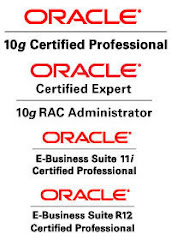Here is a quick list of the new technology features for E-Business Suite Release 12.1.1:
Versions
Database
Version 11.1.0.7 comes pre-packaged with E-Business Suite Release 12.1.1.
Version 10gR2 is still supported, for upgrades
Application Server10.1.2.3 for Forms And Reports
10.1.3.4 for Java code and OAF, HTTP Server and OJSP
Third Party TechnologyJava JDK version 6.0
Native Java Plugin for Client side browser) version 6.0 (5.0 still supported for upgrading customers).
Technology Components in APPL_TOPJDeveloper runtime libraries version 10.1.3.4
Oracle BI Beans version 3.1.1.7
Oracle Thin JDBC Drivers version 11.1.0.7
Externally Installed Technology Certified with 12.1.1Oracle AS 10g Portal 10.1.4.2
Oracle AS 10g Single Sign-on 10.1.4.3
Oracle AS 10g Discoverer 10.1.2.3
Oracle Collaboration Suite 10.1.2
Oracle Enterprise Manager 10.2.0.2
* The above require separate installation, the products mentioned don't come packaged with the distro.
Technology Configuration ManagementAutoconfig has been improved greatly in this new release of Oracle E-Business Suite:
Profiler ModeThis mode has been added to the 12.1.1 AutoConfig. When you run AutoConfig in this mode, it can generate a performance report containing timing details about each script that is run by AutoConfig.
ParallelizationAutoconfig can be run in parallel on multiple nodes, reducing downtime.
Control Dependency ManagementRedesigned service and service group definitions in the context file, enabling a service to be in different service groups and easing the addition of new services. Additional support for dependencies between service group. Introducing the possibility to enable and disable specific OC4J instances on the Application Tier Servers.
adchkcfgEnhanced to report on file system and database changes prior to running autoconfig. The report has a R12 L&F.
adbldxml on the Database TierThis utility can now be used to create new context files on the database tier to facilitate database upgrades and cross-platform migration. This feature was available in 11i, but removed in R12.0, but luckily reintroduced again in R12.1.1
AutoConfig Search UtilityRun from the command line, this utility can be used to get detailed information on context variables and the templates where these are used. Nice detail: If you don't know the entire variable name, it also accepts part of the variable name.
Technology Stack Inventory Validation ReportThis utility validates the TechStack Inventory, similar to the TechStack Validation utility. The resulting report shows component versions, installed patches and patch sets.
Application Tier File System sharingThere is now support for sharing the Application Tier File System amongst multiple Oracle E-Business Suite instances. In Release 12.0 the APPL_TOP could be shared, because the Instance Home was introduced. Now there is support to share the entire Application Tier File System (including the Application Server Tech Stacks). Refer to Metalink Note
384248.1.
Enhanced Support for DMZ deployments
New demilitarized zone (DMZ) deployment options added, like support for forward proxies, reverse proxies without external web tiers, and the option to use hardware load-balancers without an external web tier.
More information in Metalink Note 380490.1
Application Tier Load BalancingEnhancements in support for major load balancing methods: DNS, HTTP Layer and Native OC4J. Refer to Metalink Note
380489.1Network Traffic EncryptionThere is now Autoconfig support for securing the main communication with SSL: Desktop To WebServer (HTTPS), WebServer to JVM (AJPS), JVM (and other technology processes) to database (Advanced Security or Encrypted SQL*Net). See Metalink Note
376700.1Oracle Connection ManagerAutoConfig now supports Oracle Connection Manager with R12.1.1. Oracle Connection Manager is a security tool acting as a proxy server that forwards connection requests to database servers. For more information, see Metalink Note
558959.1.
One option that I cannot leave unnoticed (taken from Steven Chan's weblog):
The R12.1.1 Rapid Install allows you to upgrade to 12.1.1 from EBS 11.5.9, 11.5.10, 11.5.10.CU1, and 11.5.10.CU2. That is one cool feature to explore. Will do that soon, hopefully.
Come back soon!



